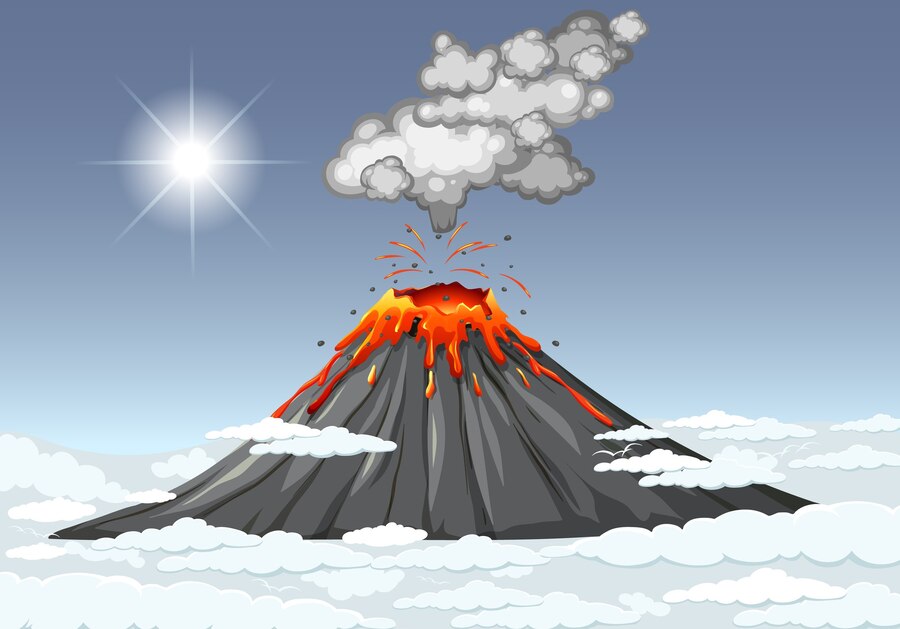Contoh soal explanation essay dan penyelesaiannya.
foto: freepik.com
Soal 1
Bacalah teks berikut dengan seksama, kemudian jawablah pertanyaan yang ada di bawahnya.
Text 1
Why is the Sky Blue?
The blue color of the sky is due to a phenomenon called scattering. Scattering occurs when the molecules and particles in the atmosphere interact with the solar radiation (sunlight). The sunlight that reaches the earth is composed of different wavelengths, which correspond to different colors. The human eye can perceive these colors as the spectrum of the rainbow: red, orange, yellow, green, blue, indigo, and violet.
The amount of scattering depends on the wavelength of the light and the size of the particles. According to Rayleigh's law, the scattering is inversely proportional to the fourth power of the wavelength. This means that shorter wavelengths (such as blue and violet) are scattered more than longer wavelengths (such as red and orange).
However, this does not explain why the sky is blue and not violet, since violet has the shortest wavelength and should be scattered the most. The reason is that the sun emits more blue light than violet, and also that the human eye is more sensitive to blue light than violet. Therefore, the combination of these factors makes the sky appear blue to us.
Pertanyaan:
1. What is the main purpose of the text?
2. What is the phenomenon that causes the blue color of the sky?
3. What is the relationship between the wavelength of light and the amount of scattering?
4. What are the two factors that make the sky appear blue and not violet?
Jawaban:
1. The main purpose of the text is to explain why the sky is blue.
2. The phenomenon that causes the blue color of the sky is scattering.
3. The relationship between the wavelength of light and the amount of scattering is inverse. Shorter wavelengths are scattered more than longer wavelengths.
4. The two factors that make the sky appear blue and not violet are the sun's emission of more blue light than violet, and the human eye's sensitivity to blue light than violet.
Soal 2
Bacalah teks berikut dengan seksama, kemudian jawablah pertanyaan yang ada di bawahnya.
Text 2
How Does a Rainbow Form?
A rainbow is a colorful arc that appears in the sky when sunlight is refracted and reflected by water droplets in the air. The formation of a rainbow involves three steps: refraction, reflection, and dispersion.
Refraction is the bending of light when it passes from one medium to another with a different density. When sunlight enters a water droplet, it is refracted at the surface of the droplet and changes its direction.
Reflection is the bouncing of light when it hits a surface. When the refracted sunlight reaches the back of the droplet, it is reflected back to the front of the droplet.
Dispersion is the splitting of white light into its component colors. When the reflected sunlight exits the droplet, it is refracted again at the surface of the droplet and changes its direction. However, this time, the angle of refraction depends on the wavelength of the light. Shorter wavelengths (such as violet and blue) are refracted more than longer wavelengths (such as red and orange). This causes the white light to split into a spectrum of colors.
The colors of the rainbow are arranged in the order of decreasing wavelength and increasing refraction: red, orange, yellow, green, blue, indigo, and violet. This is the same order as the colors of the spectrum that are produced by a prism. To see a rainbow, the observer must be positioned between the sun and the water droplets, and the sun must be behind the observer. The angle between the sun, the observer, and the center of the rainbow is about 42 degrees.
Pertanyaan:
1. What is the definition of a rainbow according to the text?
2. What are the three steps involved in the formation of a rainbow?
3. What is the difference between refraction and reflection?
4. What is the cause of dispersion of white light into a spectrum of colors?
5. What are the conditions for observing a rainbow?
Jawaban:
1. The definition of a rainbow according to the text is a colorful arc that appears in the sky when sunlight is refracted and reflected by water droplets in the air.
2. The three steps involved in the formation of a rainbow are refraction, reflection, and dispersion.
3. The difference between refraction and reflection is that refraction is the bending of light when it passes from one medium to another with a different density, while reflection is the bouncing of light when it hits a surface.
4. The cause of dispersion of white light into a spectrum of colors is the different angles of refraction for different wavelengths of light when they exit the water droplet.
5. The conditions for observing a rainbow are that the observer must be positioned between the sun and the water droplets, and the sun must be behind the observer.
foto: freepik.com
Soal 3
Bacalah teks berikut dengan seksama, kemudian jawablah pertanyaan yang ada di bawahnya.
Text 3
How Does a Volcano Erupt?
A volcano is a vent or opening in the earth's crust that allows molten rock, ash, and gas to escape from below the surface. A volcano erupts when the pressure and temperature inside the magma chamber, which is a reservoir of molten rock under the volcano, become too high. The magma then rises through cracks and fissures in the crust and reaches the surface.
There are different types of volcanic eruptions, depending on the viscosity and gas content of the magma. Viscosity is a measure of how thick or fluid a substance is. Gas content is a measure of how much dissolved gas is present in the magma. The more viscous and gas-rich the magma is, the more explosive the eruption will be.
Some examples of volcanic eruptions are:
- Hawaiian eruptions: These are the least explosive type of eruptions, characterized by the gentle outflow of very fluid and gas-poor lava. The lava forms fountains, rivers, and lakes, and can travel long distances. The lava also cools and solidifies into various shapes, such as ropes, balls, and tubes. Hawaiian eruptions are named after the volcanoes in Hawaii, where they are common.
- Strombolian eruptions: These are moderately explosive eruptions, characterized by the intermittent burst of gas-rich lava. The lava forms jets, bombs, and blocks, and can reach heights of hundreds of meters. The lava also accumulates around the vent and forms a cone-shaped mountain. Strombolian eruptions are named after the volcano Stromboli in Italy, where they are frequent.
- Vulcanian eruptions: These are very explosive eruptions, characterized by the violent ejection of viscous and gas-rich magma. The magma forms clouds, columns, and plumes of ash, dust, and rock, and can reach heights of several kilometers. The magma also falls back to the ground and forms pyroclastic flows, which are fast-moving and deadly mixtures of hot gas and solid particles. Vulcanian eruptions are named after the volcano Vulcano in Italy, where they were first observed.
- Plinian eruptions: These are the most explosive and destructive type of eruptions, characterized by the colossal blast of extremely viscous and gas-rich magma. The magma forms gigantic clouds, columns, and plumes of ash, dust, and rock, and can reach heights of tens of kilometers. The magma also falls back to the ground and forms pyroclastic flows, as well as lahars, which are mudflows of volcanic debris and water. Plinian eruptions are named after the Roman writer Pliny the Younger, who witnessed and described the eruption of Mount Vesuvius in 79 AD.
Pertanyaan:
1. What is the main cause of a volcanic eruption?
2. What are the two factors that determine the type of volcanic eruption?
3. What is the difference between viscosity and gas content?
4. What is the name of the type of eruption that produces fountains and rivers of lava?
5. What is the name of the type of eruption that produces pyroclastic flows and lahars?
Jawaban:
1. The main cause of a volcanic eruption is the high pressure and temperature inside the magma chamber.
2. The two factors that determine the type of volcanic eruption are the viscosity and gas content of the magma.
3. The difference between viscosity and gas content is that viscosity is a measure of how thick or fluid a substance is, while gas content is a measure of how much dissolved gas is present in the substance.
4. The name of the type of eruption that produces fountains and rivers of lava is Hawaiian eruption.
5. The name of the type of eruption that produces pyroclastic flows and lahars is Plinian eruption.
Soal 4
Bacalah teks berikut dengan seksama, kemudian jawablah pertanyaan yang ada di bawahnya.
Text 4
How Does a Microwave Oven Work?
A microwave oven is a device that uses electromagnetic waves to heat and cook food. Microwave ovens are different from conventional ovens, which use thermal radiation to transfer heat to the food. Microwave ovens use microwaves, which are a type of electromagnetic wave with a wavelength of about 12 centimeters and a frequency of about 2.45 gigahertz.
Microwaves are generated by a device called a magnetron, which converts electrical energy into electromagnetic energy. The magnetron consists of a cathode, an anode, and a series of magnets. When an electric current flows through the cathode, it emits electrons. The electrons are then accelerated by the electric field between the cathode and the anode, and deflected by the magnetic field around the anode. The electrons move in a circular path, creating oscillating electric and magnetic fields. These fields form microwaves, which are then directed by a waveguide to the cooking chamber.
The cooking chamber is a metal box that reflects the microwaves and prevents them from escaping. The food is placed on a rotating turntable, which ensures even exposure to the microwaves. The microwaves penetrate the food and interact with the water molecules inside. The water molecules have a positive and a negative end, which makes them polar. The microwaves cause the water molecules to rotate rapidly, creating friction and heat. The heat is then transferred to the rest of the food by conduction and convection. This is how the food is cooked in a microwave oven.
Pertanyaan:
1. What is the main purpose of the text?
2. What is the difference between a microwave oven and a conventional oven?
3. What is the device that produces microwaves in a microwave oven?
4. How do the microwaves heat the food?
5. What is the function of the turntable in the cooking chamber?
Jawaban:
1. The main purpose of the text is to explain how a microwave oven works.
2. The difference between a microwave oven and a conventional oven is that a microwave oven uses electromagnetic waves to heat and cook food, while a conventional oven uses thermal radiation to transfer heat to the food.
3. The device that produces microwaves in a microwave oven is a magnetron.
4. The microwaves heat the food by causing the water molecules inside the food to rotate rapidly, creating friction and heat.
5. The function of the turntable in the cooking chamber is to ensure even exposure of the food to the microwaves.
foto: freepik.com
Recommended By Editor
- Kenapa bantalan rel kereta api selalu pakai batu kerikil?
- Masuk angin ternyata bukan penyakit, ini penjelasan ilmiahnya
- Kenapa Kucing Hilang Bisa Kembali Sendiri ke Rumah? Ini Penjelasannya
- Sering meniup makanan dan minuman panas ganggu kesehatan?
- Gorengan bisa bikin imun tubuh turun? Ini lho faktanya
- Benarkah air kelapa bisa mengatasi keracunan makanan? Simak faktanya
- Mitos atau fakta, makan ubi bisa bikin sering kentut?



































